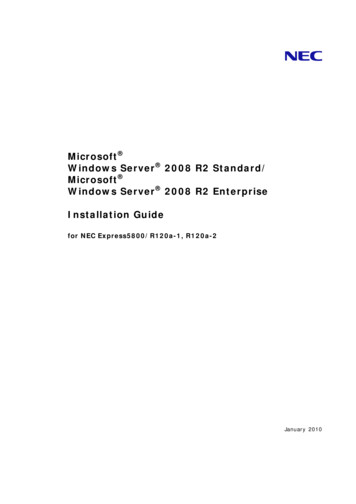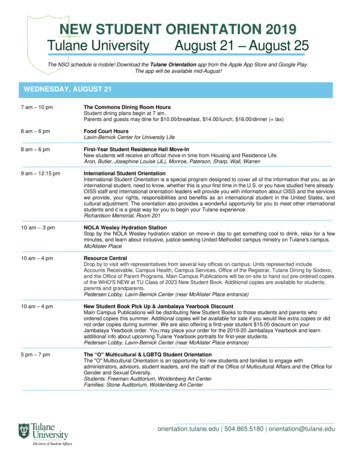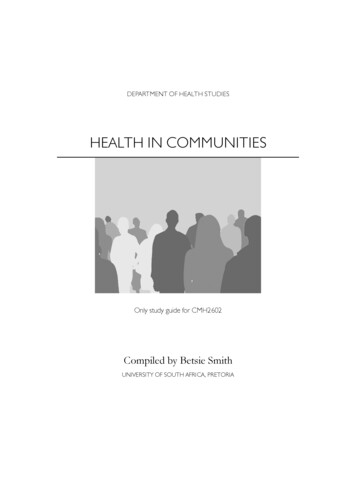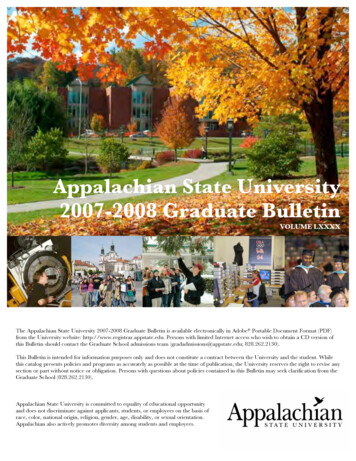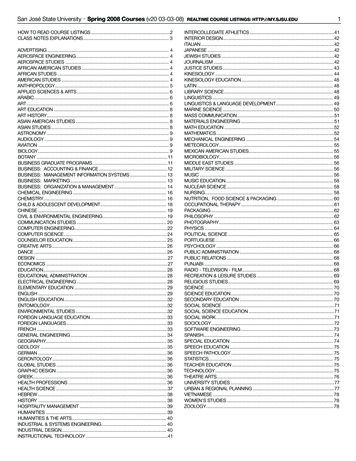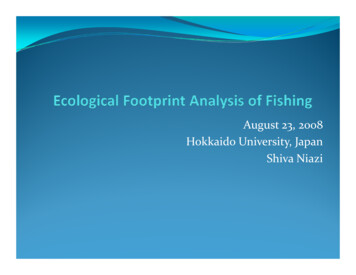
Transcription
August 23, 2008Hokkaido University, JapanShi NiShivaNiazii
Presentation Outliney Ecological Footprint: method, purpose and limitationsy Comparison of regional and national Footprintsy Fisheries component: method and limitationsy Oak Foundation research to improve fisheriesaccountingiy Global Footprint Network – partnering for a researchcollaboration
Challenge of sustainabilityHow can we all live well on one planet?
Metabolism like a cowSociety’s Metabolism
Ecological Supply(Biocapacity)
11%Deserts, Ice Capsand Barren LandBioproductive segments18%BiologicallyProductive yOcean
Personal planetoidSuBiocapacity per personGlobal average availability of bioproductiveLand Sea 1.8 global hectares/person(in 2003)
Human Demand(Ecological Footprint)
The Ecological Footprint
Energy Footprint Growing Rapidly
5 Factors Determine OvershootPopulationPer capitaConsumptionResource intensityPer capita Ecological FootprintAreaBioproductivity
Conversion from tons used oremitted to area required inglobal hectaresTons of products from land types(Production Imports –Exports)Conversion from area availableper land type to global Built-upLand*Equiivalence Facctor Adj.Yield Factor mittedEcologiccal FootpprintForestEquivalenceEe Factor AdjjustmentPastureCropsYield and Yield Facctor ological deficitDemandSupply* Built-up land is assumed to appropriate the biocapacity of cropland.
Equivalence FactorsLand componentgha/haPrimary cropland2.21Marginal cropland1 791.79Forest1.34Permanent pasture0.49Marine0.36Inland water0.36Built‐up land2.21
Global Ecological Balance Sheet(global hectares/person, 2003 data)HumanDemandHDd (Ecological(E l i l Footprint)Fi )EcologicalE l i l SupplySl (Biocapacity)(Bii )Demand Biocapacity Areas:Footprint Areas for:Growing Crops0.49Grazing Animals0.14Settlements & infrastructure0.08Producing timber & fuelwood0.23yByAbsorbing excess CO21.1425%Harvesting Fish0.15Total Global Demand2.2ExceedsSupply Crop land0.53Grazing land0.27Built-up area0.08Forest0.78Fishing Grounds0.14Total Global Supply1.8
Ecologicalof Nationsco og ca Footprintootp t oat o s
Source: WWF, 2006
Ecologicall Footprintt andPopuulation Inddexedpercentuaalincreaseto 1961Ecological Footprint per capita and Population increase,1961-2003, High Income Countries.2.0Footprint % change1.8Population % 02000
percentuaalincreaseEcologicall Footprintt andPopuulation Inddexedto 1961Ecological Footprint per capita and Population increase,1961-2003, Middle Income Countries2.5Footprint % changePopulation % change2.01.51.0050.50.019601970198019902000
EEcologicalFootprintPopullation Indeexedpercentuaalandincreasetto 1961Ecological Footprint per capita and Population increase,1961-2003, Low Income Countries3.0Footprint % changePopulation % change2.52.01.51.00.50.019601970198019902000
l i l Creditorsdid Ecologicall i lEcologicalandDebtors
When will an “overshoot” economyll?collapse?
FISHERIES
Number off kTakeGrowth12345Day678910
Global OvershootNumbber of 701980Source: WWF, 200619902000
MethodsPast Studiesy SpatialÆSpatial: Compare area for cultivation to area requiredfor sustainable cultivationy WeightÆSpatial: Determine area required for sustainableproduction for a set amount of fish, compare this to biocapacity.y Most studiesd are spatialÆspatiallÆl andd llookk at case studiesdof specific fisheries.y Footprint is weightÆspatial and look at worldwide fishcatch.
O er ie of CalculationCalc lationOverviewDEMANDHow much area is required to “sustainably”harvest the amount of fish we are consuming?Footprint Fish (tons)/Yield*EQFSUPPLYHow much area of fishing grounds does each nationhave “access” to?Biocapacity Continental Shelf Area*Yield Factor*EQF
Demand (Ecological Footprint)1 T Nile Perch10 T Catfish10% transferefficiency100 T Zooplankton1000 T Phytoplankton Primary ProductivitySource: Pauly, D. and V. Christensen. 1995. Primary production required to sustain global fisheries. Nature (374):255-257.
Footprint Fish (tons)/Yield*EQF((1))pp each ton ofCalculate the amount of pprimaryy pproductivityy necessaryy to supportfish catch, the primary productivity required (PPR). discard rate 1 PPRn 9tf efficiencyffi i transfer catch discarded bycatchdiscard rate (tons )catch(2)9:1 ratio for theconversion of wetweight to carbon(Trophic Level-1)Assumed to be aworld mean of 10%per trophic level forall speciesYield compares calculates the area needed to sustainably harvestPPRw * FAOestimateofsustainableharvestYield PPRn * Area of world continental shelf
Biocapacity Continental Shelf Area*Yield Factor*EQFy YieldYi ld FactorF t ffor BiBiocapacityit calculationl l ti iis bbaseddon primary productivity in the EEZ areaPrimary Productivity (National)Yield Factor Pr imary Pr oductivity (World )
E i lF t (EQF)EquivalenceFactorEcological Footprint & Biocapacityy Most equivalence factors in the model are based on theGlobal‐Agro‐Ecological Zones model, which assigns asuitabilityy score to all land based on its most pproductiveuse. There is no GAEZ number available for marineareas.y The equivalence factor for marine area is calculated suchthat one gha of pasture produces the calories of beefequal to the amount of calories of salmon produced in aghah off marinei area.
Sources of Error in Current Calculationy Yield Factor in biocapacity calculation is based onprimary productivity rather than fishing yields, oftenhidingg largeg changesg in fish ppopulationspdue to over‐fishing.y No aquaculturey AssumeAsame bbycatchh rate ffor allll speciesiy EQF based on assumption about productivity ratherthan data.
Research objectivesy Oak Foundation grant to review following:y Equivalence Factory Catch data‐ Sea Around Usy Aquaculture calculationsy Data ‐MaximumMaximum sustainable yieldsy Data for harvestable biomassy Conceptual model: Pauly and Christensen trophicmodel
Global Footprint Networky Ecological Footprint concept developed by WilliamRees at University of British Columbia and MathisWackernagely Global Footprint Network‐ est. 2003y Currently have 75 organizationsy Fisheries section of the Footprint‐ Prof. YoshihikoWada of Doshisha University , Justin Kitzesy Current researcher on fisheries is Sarah Rizk
Who is using the Footprint?y International:il Convention on Biodiversity, EUy National: Switzerland, Japan, Belgium, UAEy RegionsR iandd Cities:Ci i Utah,U h LLondon,dCapeCTownTy Media: Economist, Fox, Al Jazeeray NGOs:NGO WWF LivingLi i PlanetPlt ReportsRty Business: BC Hydro, GPT, US Health Care Sector
Questions?y Please visit us at : www.footprintnetwork.orgy Previous publications (Living Planet Report, ChinaReport))Ry Personal calculatory AcademicA d i publicationsbli ion methodsh dy Partner Network members and how to become apartnery Contact me: shiva@footprintnetwork.org
yEcological Footprint: method, purpose and limitations y . Carbon dioxide emitted iocapaci Forest nd Yield Fa Fishing e Factor Ad Factor Adj i valence Fa Fishing Ecologi Grounds Built-up Land* B Grounds Built-up Yield a Land E quivalenc Yield Equ Ecological deficit Demand Supply * Built-up land is assumed to appropriate the biocapacity of cropland. Equivalence Factors Land component gha/ha .



